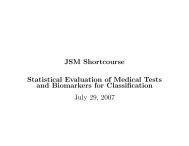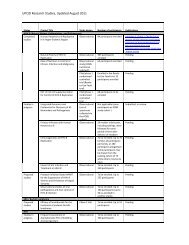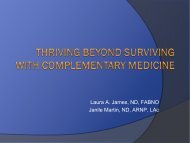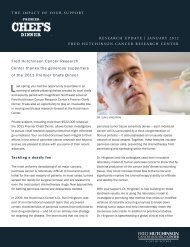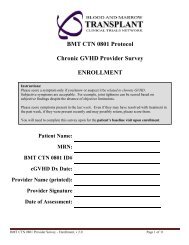Summer Undergraduate Research Program - Fred Hutchinson ...
Summer Undergraduate Research Program - Fred Hutchinson ...
Summer Undergraduate Research Program - Fred Hutchinson ...
You also want an ePaper? Increase the reach of your titles
YUMPU automatically turns print PDFs into web optimized ePapers that Google loves.
2009 Best Poster Presentation Award<br />
34 A genetic screen for regulators of cell cycle exit<br />
Charlotte Besson ,Jennifer L. Bandura, Huaqi Jiang, Derek Nickerson, and Bruce A. Edgar<br />
<strong>Fred</strong> <strong>Hutchinson</strong> Cancer <strong>Research</strong> Center, Division of Basic Sciences, 1100 Fairview Ave. N., Seattle, WA 98109<br />
1. Abstract:<br />
3. Results: 2L mutant lines #28 and #30 4. Conclusion / Discussion<br />
Uncontrolled proliferation is one of the main characteristics of a<br />
cancer cell, usually triggered by mutations in cell cycle regulator genes. Some #30 mutant cells are cycling at 24h APF<br />
Cdc2 might be involved in cell cycle exit<br />
Most cells permanently exit the cell cycle during terminal differentiation,<br />
but mechanisms involved in cell cycle exit and in its conservation after<br />
differentiation are not totally understood. A feedback loop exists between<br />
E2F and Cyclin/Cdk complexes involved in G1/S transition (A). In<br />
Drosophila, it had been shown that upon terminal differentiation, this<br />
feedback loop disappears (B). Furthermore, it has been shown that RBF<br />
and Dap alone cannot explain cell cycle exit, indicating that unknown<br />
inhibitors of E2F and/or CyclinE/Cdk2 are involved in that process(C). To<br />
identify what those inhibitors are, we performed a genetic screen, set up<br />
to identify new genes involved in silencing cell cycle gene transcription<br />
upon differentiation in the eye.<br />
Cycling cells Upon differenciation Double insurance<br />
mecanism<br />
2. Background:<br />
pcna-miniW + and genetic screen<br />
(A) The pcna-miniW + (A) The pcna-miniW reporter : A single E2F binding site within the PCNA<br />
+ reporter : A single E2F binding site within the PCNA<br />
enhancer/promoter is necessary for G1/S-directed gene expression.<br />
The white gene results in red eye color in flies if expressed at 1-2 days<br />
after puparium formation (APF), a time when cell divisions have<br />
normally ceased, so as E2F activity. Flies with a W- background<br />
carrying this reporter had been mutagenised with EMS.<br />
(B) When cell cycle exit isn’t delayed, flies have a white eye phenotype.<br />
(C) When a mutation induces a cell cycle exit delay or bypass, E2F is still<br />
activated during the white gene critical period. We then screened for<br />
flies with a red eye phenotype.<br />
A<br />
A’<br />
DNA GFP PH3<br />
(A,A’) - Mutant clones of #30 in pupal eyes 24H APF presenting a PH3<br />
staining, showing that those cell D’ are still undergoing mitosis at<br />
this time point.<br />
(B,B’) - Mutant clones of #30 in pupal eyes 24H APF presenting a BrdU<br />
incorporation staining, showing that those cells are still<br />
undergoing S-phase phase at this time point.<br />
Mutant clones are marked by the absence of GFP<br />
Some #30 mutant cells are undergoing mitosis<br />
at 28h APF<br />
A’<br />
163<br />
GFP<br />
PH3<br />
#30 mutant clones in pupal eyes 28H APF presenting a PH3 staining,<br />
showing that those cell are still undergoing mitosis.<br />
Mutant clones are marked by the absence of GFP<br />
#28 and #30 are mutated in cdc2 ED L1 L2 L3 Pupa Adult<br />
A.<br />
B<br />
cdc2E1-9 B<br />
cdc2 and # 28 mutant clones:<br />
B<br />
- Delay of cell cycle exit from 24h APF to ~ 28h APF<br />
- Not obvious when clones were induced by hsFLP at 60H AED<br />
High levels of cdc2 are required in asymmetric divisions. Low levels of<br />
cdc2 do not affect mitosis entry, but disturb asymmetrically localized<br />
proteins during mitosis. (Tio et al, 2001)<br />
miniW +<br />
E2F<br />
A.<br />
PCNA<br />
ATG<br />
~230 bp PCNA enhancer /<br />
promoter<br />
miniW<br />
W<br />
B.<br />
- promoter<br />
Background<br />
10 Candidat genes:Mutant Lines Available for 3<br />
CG5091 Glucosyltransferase activity (1 line)<br />
Cdc2 Cyclin-dependent protein kinase activity (5 lines)<br />
Da Transcription factor<br />
Screening<br />
EMS mutagenesis C. #28 (687): C=>T<br />
#30 (274): G=>A<br />
Arginine<br />
Proline<br />
B. WT<br />
24h APF<br />
W<br />
(A) Recombination mapping predicted<br />
10821061 +/- ~334kb. We<br />
complementation crosses with<br />
ED L1 L2 L3 Pupa Adult<br />
Cell cycle exit upon<br />
reduce the region of interest<br />
region).<br />
+<br />
Cell cycle exit upon<br />
differentiation<br />
C. Delayed cell cycle exit 24h APF<br />
W<br />
ED L1 L2 L3 Pupa Adult<br />
region).<br />
(B) The 2L: 10381211; 10406409 region<br />
and #30 mutant lines failed to complement<br />
for cdc2, indicating that those lines<br />
partner.<br />
(C) After sequencing cdc2 in both line<br />
#28 and #30 are mutant for cdc2<br />
+<br />
C. Delayed cell cycle exit<br />
#28 and #30 are mutant for cdc2<br />
as an amorph allele: cdc2E1-9 10 Candidat genes:Mutant Lines Available for 3 Complementation<br />
Glucosyltransferase activity (1 line) Yes<br />
dependent protein kinase activity (5 lines) NO<br />
(2 lines) Yes<br />
Mapping confirmation: rescue experiments (for lethality and cell<br />
cycle exit phenotype : system Gal-4, UAS-cdc2)<br />
Does a KO of cdc2 present the same phenotype? (RNAi line<br />
experiment)<br />
Are mutant clones developmentally delayed? (Staining for<br />
differentiation markers)<br />
Arginine => Glutamine (123)<br />
Proline => Serine(242)<br />
Do levels of cdc2 affect the cell cycle exit phenotype? (Heat shock<br />
at different time points, temperature sensitive allele of cdc2)<br />
predicted that mutations should be at 2L<br />
tested regions in orange by<br />
deficiency lines. This allowed us to 5. References<br />
ED L1 L2 L3 Pupa Adult<br />
Cell cycle exit upon<br />
differentiation<br />
to 2L: 10381211; 10406409. (red<br />
region had 10 candidates genes. #28<br />
complement with 5 deficiency lines<br />
lines are mutated in cdc2 or in a cdc2<br />
lines, we have been able to show that<br />
2. #30 had previously been described<br />
Buttitta, L. A., Katzaroff, A. J., Perez, C. L., de la Cruz, A., and Edgar, B. A.<br />
(2007) A double-assurance mechanism controls cell cycle exit upon<br />
terminal differentiation in Drosophila. Developmental Cell 12: 631-643.<br />
Thacker, S. A., Bonnette, P. C., and Duronio, R. J. (2003) The contribution<br />
of E2F-regulated transcription to Drosophila PCNA gene function.<br />
Current Biology 13: 53-58.<br />
Tio, M., Udolph, G., Yang, X. et al (2001). Cdc2 links the Drosophila cell<br />
cycle and asymmetric division machineries. Nature, 409: 1063-1067<br />
B’<br />
B’<br />
10821061<br />
GFP BrdU<br />
The Cell cycle exit phenotype is not evident when clones<br />
are induced later (with an hsFLP system, instead of eyFLP):<br />
an low levels of cdc2 affect cell cycle exit?<br />
Cdc2 and Cell cycle exit phenotype:<br />
Hypothesis<br />
Cdc2 level EyFLP hsFLP<br />
24 h<br />
APF<br />
Threshold<br />
level of cdc2:<br />
For cell cycle<br />
exit phenotype<br />
For G2/M<br />
transition<br />
Cdc 2 needs to be present in high level during differentiation to<br />
induce cell cycle exit.<br />
Work in progress




